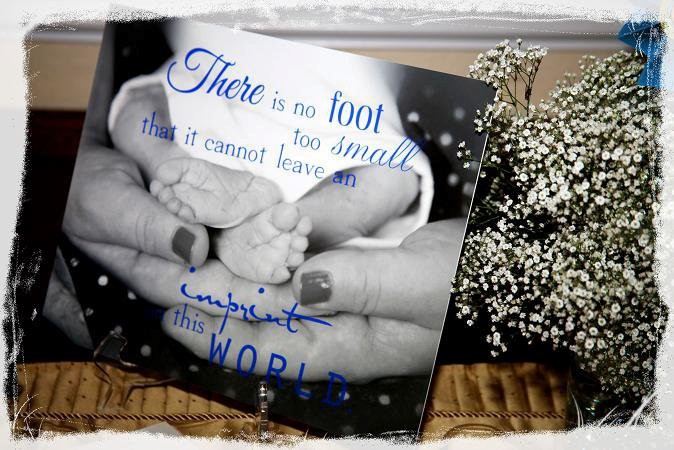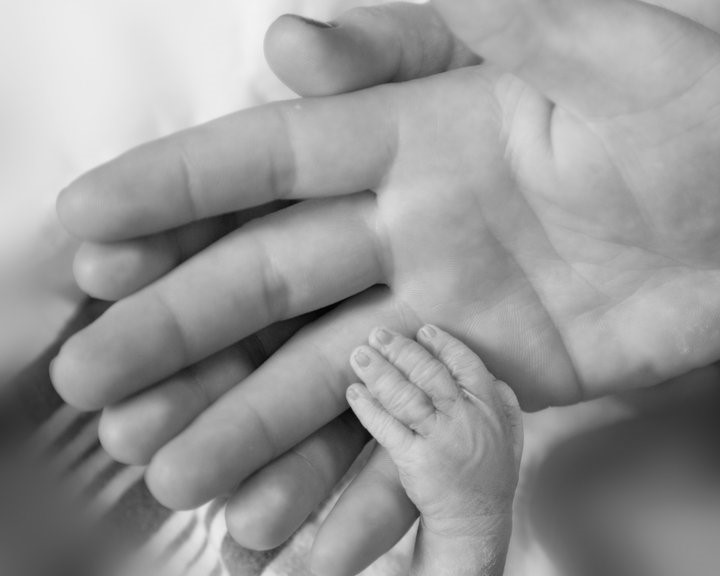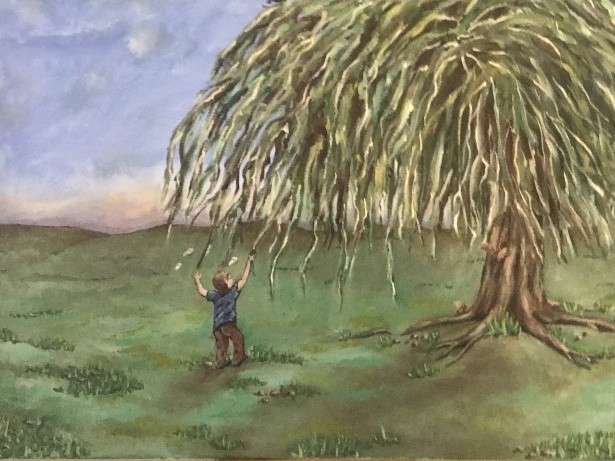
By Sarah Taylor
Art Therapy Graduate Student Intern, St. Mary of the Woods College
An estimated 1 in 4 women will experience the loss of a child during pregnancy or the first year of the child’s life. Historically these women were discouraged from holding their stillborn child or attending the funeral. Families were encouraged to not speak about the loss and to quickly “move on.” This slowly began to change in 1988 when October was recognized by President Ronald Reagan as Pregnancy and Infant Loss Awareness month. Then in 2002 a community of parents that had experienced loss designated October 15th as Pregnancy and Loss Remembrance Day. Slowly practitioners have begun to recognize the physical and emotional implications that living with loss has on both parents. Through use of social media and the film industries increased depictions of loss more families have become outspoken about their child’s story.
 As a mom of loss, I have experienced the trauma of both stillbirth at 36 weeks gestation and an early miscarriage. There were so many things that I wished others had understood so I began to openly speak about my own birth story and continued trauma over the past 10 years. I also started listening to other mothers and the struggles that they continued to face. The immediate experience of a miscarriage, stillbirth, or infant loss is trauma. Again, this is TRAUMA! It was months after my son was born before anyone looked at me and identified this. I have heard multiple stories of women going months or years with symptoms of PTSD without anyone acknowledging that what they were experiencing was because they had been through trauma. Instead many of us are told it is grief and will pass. This can leave a woman feeling that they are grieving poorly or are never going to have a “normal” life again. While the symptoms may lessen until they are barely noticeable we will live with this experience for the rest of our lives. We are the keepers of our children’s lives. Because of this it is possible over time for our trauma to be transformed into beautiful stories. This happens by digging through the trauma and finding the moments of love. The moment we held our stillborn child, when we found out we were pregnant, hearing a heartbeat, or feeling a kick. For children that live for a short time we have these same memories as well as their first smile or the first time they held our fingers
As a mom of loss, I have experienced the trauma of both stillbirth at 36 weeks gestation and an early miscarriage. There were so many things that I wished others had understood so I began to openly speak about my own birth story and continued trauma over the past 10 years. I also started listening to other mothers and the struggles that they continued to face. The immediate experience of a miscarriage, stillbirth, or infant loss is trauma. Again, this is TRAUMA! It was months after my son was born before anyone looked at me and identified this. I have heard multiple stories of women going months or years with symptoms of PTSD without anyone acknowledging that what they were experiencing was because they had been through trauma. Instead many of us are told it is grief and will pass. This can leave a woman feeling that they are grieving poorly or are never going to have a “normal” life again. While the symptoms may lessen until they are barely noticeable we will live with this experience for the rest of our lives. We are the keepers of our children’s lives. Because of this it is possible over time for our trauma to be transformed into beautiful stories. This happens by digging through the trauma and finding the moments of love. The moment we held our stillborn child, when we found out we were pregnant, hearing a heartbeat, or feeling a kick. For children that live for a short time we have these same memories as well as their first smile or the first time they held our fingers
 As an emerging art therapist, I have come to realize that there is more to the story than the immediate trauma. Parents of loss also face a series of microtraumas from immediately after the birth or death of their child and these may continue for years. These microtraumas vary depending on the type of support systems the parents have and the involvement of family. Statements such as “you can always have another baby” or “at least they are not hurting anymore” minimize the child’s life and the identity of the parents as parents. Microtraumas may also look like the first time no one reaches out on the child’s birthday, facing holidays without the child, feeling pressured to hold another baby, or even attending a baby shower. For fathers this may be facing the fact that most of the support systems in place are primarily there to support the mothers. Each microtrauma can bring back the feelings from the initial trauma and draw the focus back to that point, causing the parent to relive the experience of loss over again. However, it is important to process the microtraumas for parents to be able to identify them for what they are. By working through microtraumas parents are better prepared for these situations and will be more equipped to respond instead of reacting.
As an emerging art therapist, I have come to realize that there is more to the story than the immediate trauma. Parents of loss also face a series of microtraumas from immediately after the birth or death of their child and these may continue for years. These microtraumas vary depending on the type of support systems the parents have and the involvement of family. Statements such as “you can always have another baby” or “at least they are not hurting anymore” minimize the child’s life and the identity of the parents as parents. Microtraumas may also look like the first time no one reaches out on the child’s birthday, facing holidays without the child, feeling pressured to hold another baby, or even attending a baby shower. For fathers this may be facing the fact that most of the support systems in place are primarily there to support the mothers. Each microtrauma can bring back the feelings from the initial trauma and draw the focus back to that point, causing the parent to relive the experience of loss over again. However, it is important to process the microtraumas for parents to be able to identify them for what they are. By working through microtraumas parents are better prepared for these situations and will be more equipped to respond instead of reacting.
 As therapists we need to be aware of how expansive and impactful the loss of a child at any stage is. We also need to acknowledge that parents are still living their lives. They are working toward creating a “new normal.” This is a life where parents are living with the memory of a child, finding ways to honor them through traditions, are redefining what is important, and are learning how to interact in a world that may not fully understand them anymore. With a divorce rate of over 90% for couples that have lost a child, there is a need for help to navigate differing styles of grief. They may need to learn how to communicate again, how to process their anger, dealing with feelings of guilt or blame, or they may be faced with financial struggles due to medical bills or the mother’s inability to return to her job. We can use the therapeutic time to help empower these parents to create a new normal that allows for both joy and grief to have a place. I have found that the use of response art has helped me to break free of feelings of guilt and anger and even answer many of the internal questions that haunted me. I have also been able to share my visual art with my spouse to help explain where I am in the grieving process. Likewise, he has been able to use his writing to help me understand him. These creative conversations have become part of our own new normal.
As therapists we need to be aware of how expansive and impactful the loss of a child at any stage is. We also need to acknowledge that parents are still living their lives. They are working toward creating a “new normal.” This is a life where parents are living with the memory of a child, finding ways to honor them through traditions, are redefining what is important, and are learning how to interact in a world that may not fully understand them anymore. With a divorce rate of over 90% for couples that have lost a child, there is a need for help to navigate differing styles of grief. They may need to learn how to communicate again, how to process their anger, dealing with feelings of guilt or blame, or they may be faced with financial struggles due to medical bills or the mother’s inability to return to her job. We can use the therapeutic time to help empower these parents to create a new normal that allows for both joy and grief to have a place. I have found that the use of response art has helped me to break free of feelings of guilt and anger and even answer many of the internal questions that haunted me. I have also been able to share my visual art with my spouse to help explain where I am in the grieving process. Likewise, he has been able to use his writing to help me understand him. These creative conversations have become part of our own new normal.
How to help
The support of family and friends is vital for parents as they walk through the grieving process. While each person’s journey through grief is different there are a few things that the parents support systems can regularly do to support them.
- Say the child’s name!
- I know this may sound simple. However, when support systems say the child’s name it helps the parents to feel accepted and free to talk about their child. Parents love to share stories about their children. Just because the stories may seem sad these stories are what the parents have. Over time these stories can become less shrouded in grief and more about stories of love.
- Remembering important dates
- Due dates and birth dates are often forgotten when a child has passed or after the first couple years. These dates can be very difficult for parents. A card, text, or small donation in the child’s name help to support the parents and know that their child has been remembered.
- Giving space to grieve
- There is no time limit on grief. Some individuals may have intense grief for a month or two while others may experience it strongly for the first couple years. In some cases, a parent may experience moments of grief that seem to appear out of the blue. Remember that these parents are missing a part of themselves. Friends and family can help by releasing their own expectations on the length of time parents grieve.
- Refrain from platitudes
- Sayings such as “God needed another angel,” “you can always have more children,” “at least they are not suffering anymore,” “or “maybe this was for the best” are extremely hurtful. These sayings belittle the life of the child and can cause long term damage in your relationship with the parent.
- Acknowledge your own feelings
- Do not be afraid to let the parent know that you do not know what to say or how to act. Let them know you are uncomfortable but want to move past that and be there for them.
- If you are sad and tear up at the story of the child’s life that is alright. Sharing the grief can help to take some of the pressure off feeling alone for parents. Just be cautious your own emotions do not overshadow or overwhelm the parents.
- Ask permission!
- If you would like to do something to honor the child or have something at home to remember the child ask the parents first. This honors their role as the child’s parent.
- Participate
- Parents of loss often have traditions that they participate in. These could be balloon releases, candle lightings, having a birthday party, or putting together care packages for other parents experiencing loss. By participating you are validating the life of the child.
Resources:
- Now I Lay Me Down to Sleep (https://www.nowilaymedowntosleep.org/) — These photographers are trained to and edit pictures of babies that are stillborn or are in the NICU with life threatening illnesses free of charge. They will often also provide clothing, diapers, and molds of the child’s hand or footprint free of charge.
- Weighted bears and other remembrance items — There are multiple sites a parent can order a bear that weighs the same as their baby or other various items that honor the life of the child. (https://mollybears.org/, https://www.nowilaymedowntosleep.org/, http://www.projectbear.com/, and more)
- Still Standing Magazine — This is an online publication that provides information and support for families, practitioners, and the parents experiencing the loss. https://stillstandingmag.com/
- Support Groups — There are many online and local support groups that offer monthly or annual meetings, retreats, and resources for parents and families. (https://www.gatheringhope.net/, https://rtzhope.org/, https://www.mend.org/, https://www.mend.org,
*Picture provided taken by Amber Augustine with Tiny Works of Heart of Maxwell “Max” Taylor, stillborn in 2010. Max and the Willow Tree by Sarah Taylor, 2020.